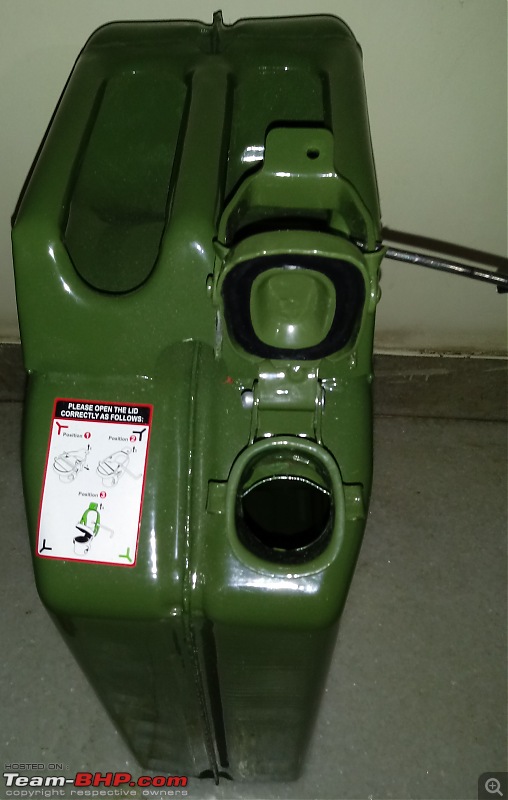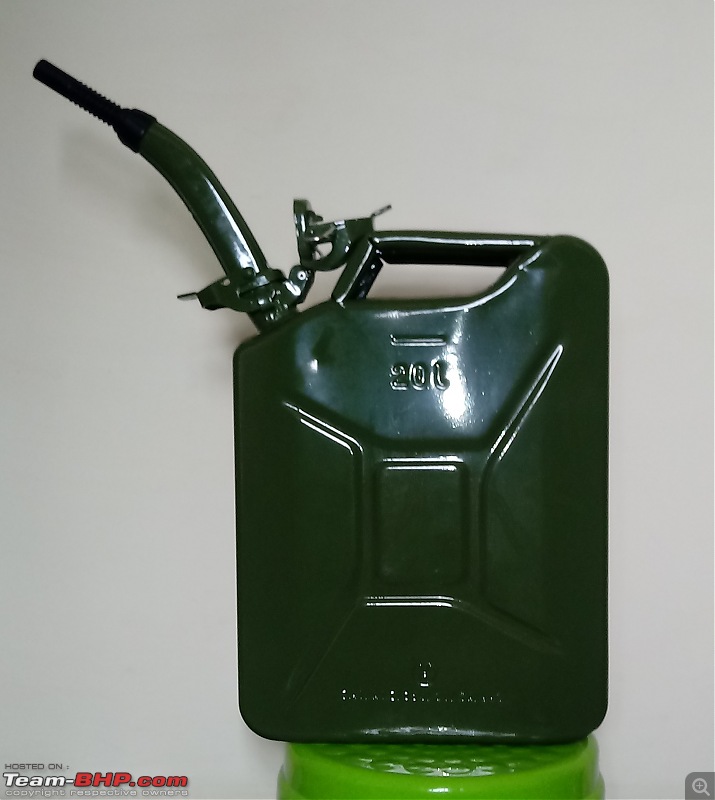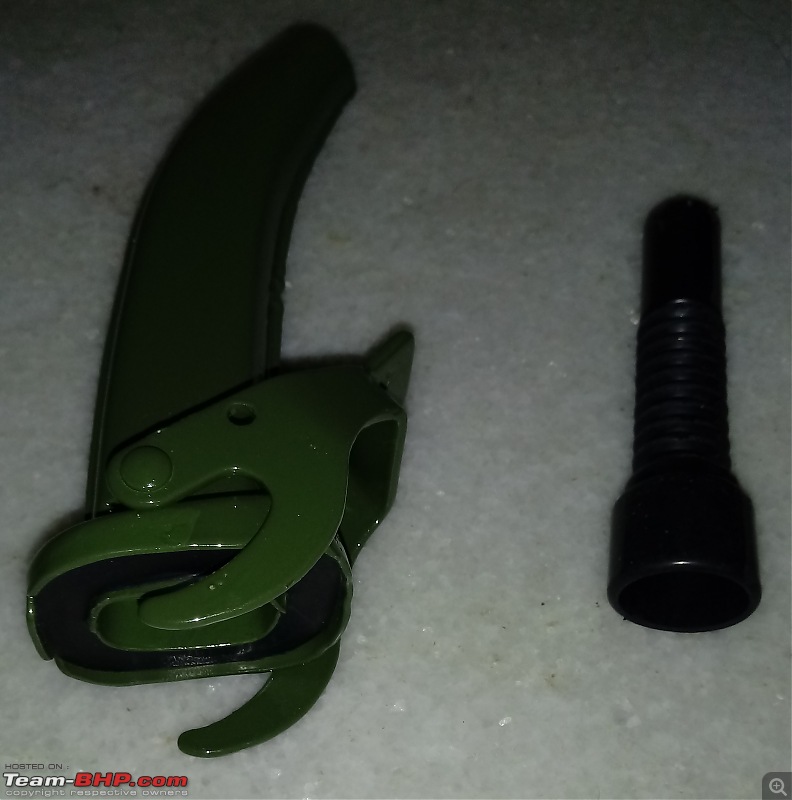Jerry Can for my car
A brief history : Originally named the "Wehrmacht-Einheitskanister" by the Germans and developed in the late 1930s, the name "Jerry Can" was coined by Americans for the 20 litre or 5 gallon fuel containers since "Jerry" was a nickname given to German soldiers by Allied forces during World War II. The older fuel containers used by the Allied armies were of very poor quality and design which usually restricted them to only a single usage per container along with a smaller size. The 20 litre jerry can was a closely guarded secret till 1939 when an American engineer managed to smuggle one out of Germany to Calcutta and eventually to America. The original German design with the cam lever release mechanism (also known as a bayonet spout) has remained largely unchanged to this day and is still used by various armies including UN and NATO peacekeeping forces till date. The American version is slightly different with a screw cap and a small pressure release valve.
Unique features : An ideal 20 litre fuel jerry can has some unique features. It has a boxed X-like indented marking on two sides to increase its structural strength. This also makes it resistant to impacts and allows the fuel to expand if necessary. The container is usually made of steel and has recessed seams. It has 3 handles so that it can be carried by one person (middle handle) or two people (two side-handles). It also has the ability to float on water due to the presence of an air pocket below the handle area when fuel is filled in it correctly up to the recommended mark. The additional spout is also made of steel, has the same rubber seal as the cap and has the exact same fitting mechanism as the cap except in an opposite direction. There is also an additional rubber spout that needs to be fit onto the metal spout to prevent the metal spout from causing damage to the fuel receptacle area of your car and/or vice versa.
Top 5 reasons why you may need Jerry Cans :-
1) The fuel station may be located in an unsafe area where it might not be a good idea to stop the vehicle.
2) The fuel station may have run out of the fuel required for your car.
3) Fuel stations may be few and far between.
4) You want to avoid buying fuel from rarely used fuel stations to minimize the chances of water ingressing into the fuel tank of your car.
5) You want to calculate fuel efficiency and/or want to cover the maximum possible distance with your car.
Bonus reason : You have access to good quality fuel now but may not get it later.
Legal issues in India : In general, it is illegal to carry fuel in the cabin area and boot area of private cars if that boot area is accessible from the cabin. However, the law also allows the storage of reasonable quantities of fuel in suitable containers in the car's boot and/or cabin area in anticipation of exceptional circumstances, some of which are mentioned as reasons for getting a jerry can above.
Colour codes for jerry cans :
American system :-
Red = All unleaded Gasoline/Petrol
Yellow = Diesel
British system :-
Green = Unleaded petrol/gasoline
Yellow = E 85
Black = Diesel
There are other colours allocated for other fuels too like kerosene, etc. Sadly, I am not sure if India has a colour code for fuel jerry cans.
Advantages and disadvantages of the various designs and materials used :
1) The advantage of the original German designed steel fuel jerry can is that these are very durable. However, their main disadvantage is that these do not have a pressure release mechanism. The pressure builds up over time with the fuel (mainly petrol/gasoline) getting vaporized inside the jerry can due to the sloshing around of the fuel in a moving vehicle. This pressure needs to be released periodically by opening the can's cap to prevent the jerry can from cracking open.
2) The primary advantage of the newer American designed fuel jerry cans is that these are easier to use since they can be made of either steel or plastic and have a venting mechanism on the cap. Additionally, the plastic ones often have baffles built inside the cans that prevent the fuel from sloshing around to a large extent. However, the plastic fuel jerry cans are substantially more expensive but not very durable and usually cannot withstand much of an impact when compared to the steel ones. Also, the newer American designed jerry cans are very prone to leakages from the cap area especially due to the presence of the venting mechanism.
3) Jerry cans are also made of aluminium and those are approximately around 20% lighter than the steel ones. However, there is always the risk of the aluminium getting corroded by ethanol-blended fuels especially in a country with a hot climate like India.
4) Additionally, you have to be physically fit to handle such jerry cans. This is because 20 litres of BS6 petrol can easily weigh upto a maximum of around 15.5 kgs. Similarly, 20 litres of BS6 diesel can weigh up to a maximum of around 17.2 kgs. The jerry can that I got weighs approximately 5 kgs with the additional spout when empty. So you are looking at a combined weight (fuel + jerry can) of around 20.5 kgs for petrol and 22.2 kgs for diesel . As the saying goes "Do you even lift ?"

However, there are fuel jerry cans available in smaller sizes as well.
The prices of jerry cans on websites like Amazon, Flipkart, etc are exorbitant. After much brainstorming and weighing the pros and cons, I got a 20 litre steel (built as per UN regulations with properly embossed markings) jerry can with a German-designed cap and spout for my petrol Creta for INR 1500 from a local shop here in Kolkata (earlier known as Calcutta. Full circle ?) Coincidentally, this is the exact same design as the 20 litre jerry cans used by various agencies under the Government of India and other private agencies to deliver fuel as a part of the doorstep fuel delivery initiative. I intend to keep this tied to the back of the front passenger seat of my 1st generation Hyundai Creta. Here are a few pictures :-
You can read more about the UN specifications for fuel jerry cans in the following link :
https://unece.org/DAM/trans/danger/p...ume2_Part4.pdf
I hope that you enjoyed reading this and found it informative. Wish you happy and safe drives ahead

 (1)
Thanks
(1)
Thanks
 (1)
Thanks
(1)
Thanks
 (1)
Thanks
(1)
Thanks
 (1)
Thanks
(1)
Thanks

 (1)
Thanks
(1)
Thanks
 (1)
Thanks
(1)
Thanks
 (8)
Thanks
(8)
Thanks
 (1)
Thanks
(1)
Thanks






 However, there are fuel jerry cans available in smaller sizes as well.
However, there are fuel jerry cans available in smaller sizes as well.



